People
‘This Is My Swan Song’: After a Brush With Death, Tracey Emin Has Returned to Her Hometown to Build a Museum and Write Her Legacy
After she dies, the artist wants her new Margate studio to become a museum.

After she dies, the artist wants her new Margate studio to become a museum.

Naomi Rea

Tracey Emin was talking to me from her bed.
I was also in bed, but I didn’t tell her this, because I didn’t have a very good excuse. Bed rest is imperative for Emin, on the other hand, who, while the rest of the world was struggling to survive a pandemic last year, was undergoing her own battle with bladder cancer. The artist, who is 58, has since been given the all-clear, but only after undergoing extensive surgery to remove her bladder, womb, urethra, parts of her intestines and lymph nodes, as well as half of her vagina. Emin, whose work has often drawn from autobiographical traumas, is unflinching about these realities.
The artist recently moved back to her hometown of Margate, but she was in London for a doctor’s visit when we spoke. She was planning to head to the Royal Academy that evening, where she is showing work in its delayed summer exhibition, and she needed to conserve her energy. After cancer—if you are so lucky as to have an “after”—there is recovery, and the grim aftereffects of Emin’s surgery include exhaustion, problems walking, and living with a urostomy bag that can fill up with urine as often as every 20 minutes.
“I have all these ailments that I’ve got to get over and learn to live with, and that’s what I’m doing,” she said. “I’m getting better at it. I don’t feel whole, because I had parts of me taken away, but I’ve been given something else that I didn’t have before.”
That something else includes a luxury she never thought she would have again: time. “I am so much better and so much happier and more well, and more looking forward to the future,” she said. “Now I don’t mind wasting time. I feel more happy about doing nothing than ever in my life.”
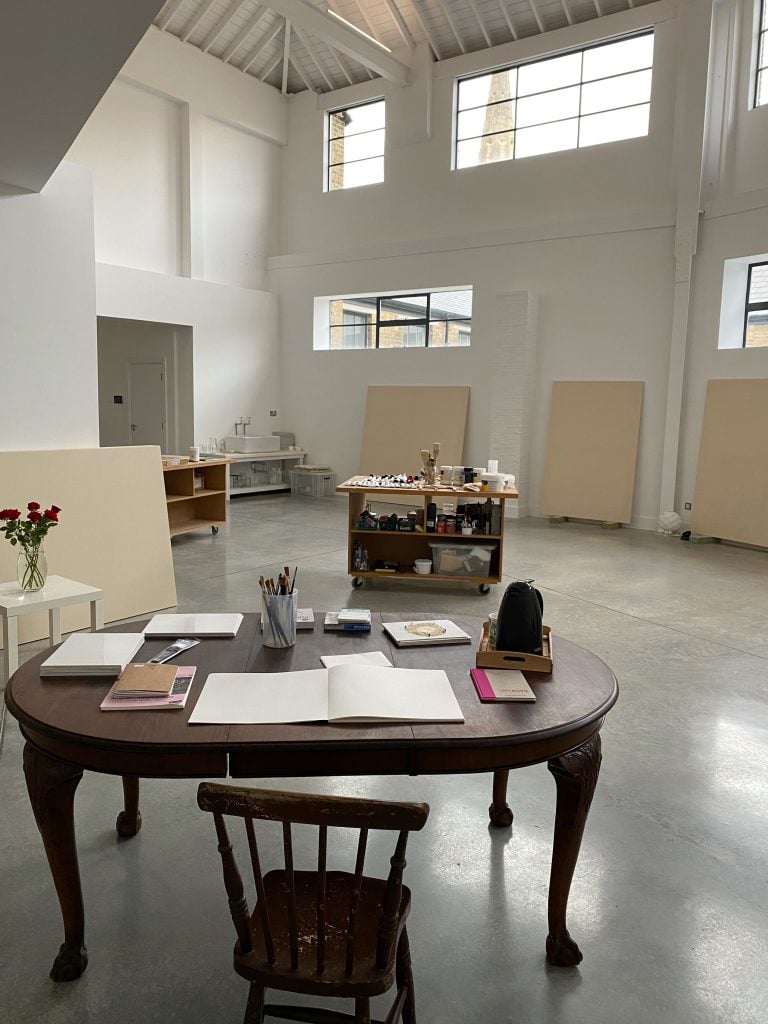
Tracey Emin’s studio. Photo by Tracey Emin.
After her mother died, Emin felt compelled to return to Margate, the seaside town where a dysfunctional childhood punctuated with trauma led her to drop out of school at 13 years old. Now she has just completed work on a massive new home and studio complex that took more than four years to complete.
“It’s interesting because it feels like this full cycle of stuff. In your life, when do you let things go? When do you relinquish? When do you return? With Margate, I have never let go, ever,” she said.
Emin bought the 30,000-square-foot industrial space—the former site of a commercial printer—in 2016 with the gallerist Carl Freedman, a close friend and long ago ex-boyfriend, who has moved his East London gallery and print business into the other half. Emin’s side includes a sculpture studio and an adjacent coach house, which she said has a Japanese “zen” atmosphere. But the main event is the artist’s large painting studio, the design for which Gabriel Chipperfield consulted on, and upstairs, “the horseshoe”—where she lives.
Emin said she started out the project thinking it would be a cheap fix up, but that she ended up piling her “heart and soul” (and “a lot more money” than she intended to spend) into it. Exactly what was happening didn’t become clear until she got the cancer diagnosis last June, and became unsure if she would see the other side of Christmas.
“I realized what I had been doing,” she said. “I was building my museum. And my mausoleum as well. So that when I die, my work can be shown in Margate exactly how I want it to be seen.”
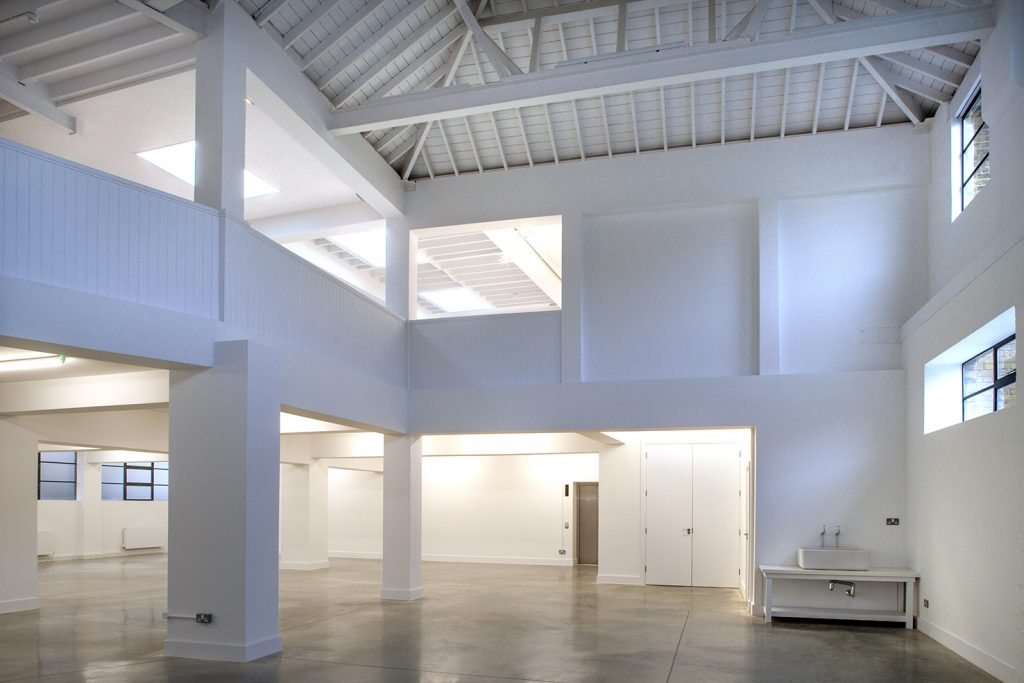
Tracey Emin Studio. Photo by Carlos Dominguez Photography.
After she dies, the space will be turned into a museum to house her work as well as her extensive archive of some 30,000 photographs, 2,000 works on paper, 500 framed drawings, and critical essays and catalogues that will form a research library. The realization of the project also means that she finally has somewhere to hang her eclectic art collection, which she calls “Other People’s Art,” and which spans everything from ceramics to her most recent purchase, a work by Margate-based artist Lindsey Mendick.
Her vision for Margate was partly informed by a visit to Marfa, Texas, a few years ago, and seeing what Donald Judd had done there to cement his legacy. (Judd bought a compound of decommissioned military buildings to show his art in a non-museum setting.) “If you go somewhere and see his works displayed really crappily or in these stupid ways, you feel a bit disappointed, but when you go to Marfa, there’s no mistakes,” she said. “It’s all exactly how he wanted things to be seen.”
At times, Emin has wondered whether she made a mistake. “Because of my upbringing and childhood in Margate being so traumatic and strange, I was really afraid of the ghosts,” she said. The longest she had spent back in her hometown as an adult was a two-week stint installing an exhibition at Turner Contemporary, and it prompted her to have a meltdown.
“But this time, the absolute opposite happened,” she said. “It was kind of like an exorcism and I felt reborn, and I felt like: I’m home.”
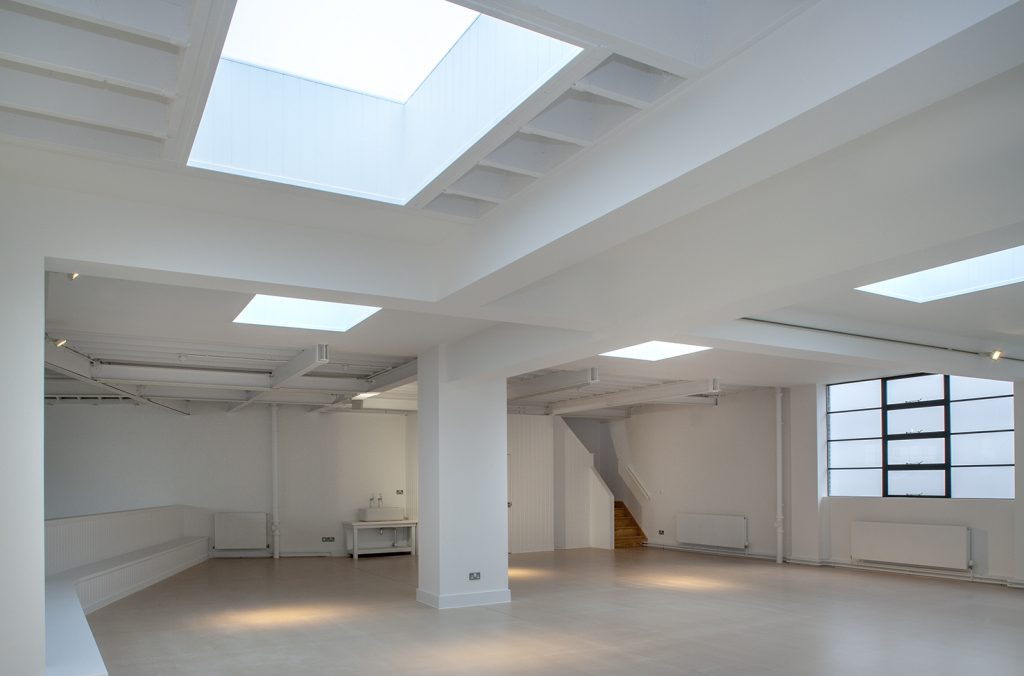
Tracey Emin Studio. Photo by Carlos Dominguez Photography.
Margate feels like a different place now, too, largely due to the influx of the arts who have moved to the city since the Turner Contemporary art museum was established in 2011. “Before Turner, the whole place was boarded up, and the streets were paved in dog shit,” Emin said. While some 18,000 people in Margate still live below the U.K. poverty line, it is fast becoming a trendy getaway enclave replete with cottage industries and vintage shops. The musician Pete Doherty opened a hotel there this year, and Gabriel Chipperfield is in talks to build another with Frieze co-founder Matthew Slotover.
“Now I feel really good because I’ve got this amazing, beautiful place to work and live in, and I know what’s going to happen to my legacy after I die,” Emin said.
Her brush with death has made her rethink how she wants her work to be shown when she no longer has control over it. “The parts of my career that have failed miserably have all been about the fact that my work has been shown in the wrong context,” she said.
When she thought she was dying, she wrote up a list of artists, places, and contexts in which she never wants her work to be shown. She wouldn’t reveal exactly what those are, but she hinted that it’s not with her fellow YBAs, or even contemporary artists at all. Instead, she wants her work to continue the dialogue with modern masters that she’s started in recent years. Next month, she will show alongside Edvard Munch to inaugurate the new Munch Museum in Oslo. Meanwhile, her famous tangle of depression sheets My Bed has been shown next to work by Francis Bacon, J.M.W. Turner, and William Blake, and she collaborated with Louise Bourgeois before she died.
“That’s the correct context for my work,” she said.
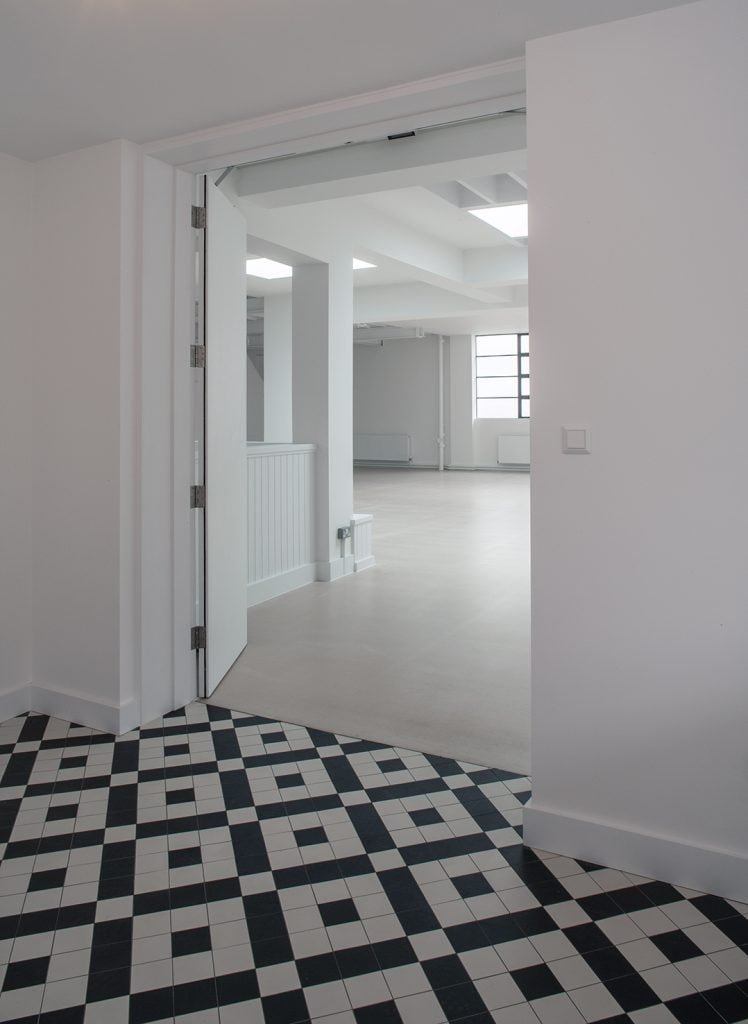
Tracey Emin Studio. Photo by Carlos Dominguez Photography.
Her phone pinged as we talked. Her assistant was texting her from Oslo, where he was installing My Bed for the first time without Emin.
“People were saying, why is Tracey Emin showing with Munch? But these people hadn’t even seen my work,” she said. “They don’t understand what my work’s about. They think about something which hit the headlines 20 years ago.”
Our conversation swung to my own emotional experience seeing a show in Margate that paired her unmade bed with Turner’s paintings of pillowy skies; people couldn’t imagine how the two could relate, but they did. It’s like that with lot of Emin’s work; there’s a sense of timelessness to it, which means it can make more sense hanging side by side with Käthe Kollwitz or Richard Diebenkorn than with some of the much-hyped stars of painting today.
After a forced hiatus due to her illness, Emin has returned to the studio with vigor. She is still making clay sculptures, and the occasional neon, but her primary focus has been on painting.
Emin has a complicated history with painting. She studied it at the Royal College of Art, but stopped when she became pregnant and the smell of oil paint started to make her sick. After she had an abortion, she found she couldn’t paint anymore. She went on to make a flurry of work in 1996 as part of her conceptual piece Exorcism of the Last Painting I Ever Made, but didn’t fully return to showing her painting for another decade after that.
“I deeply fucking regret not continuing painting when I left college,” she said.
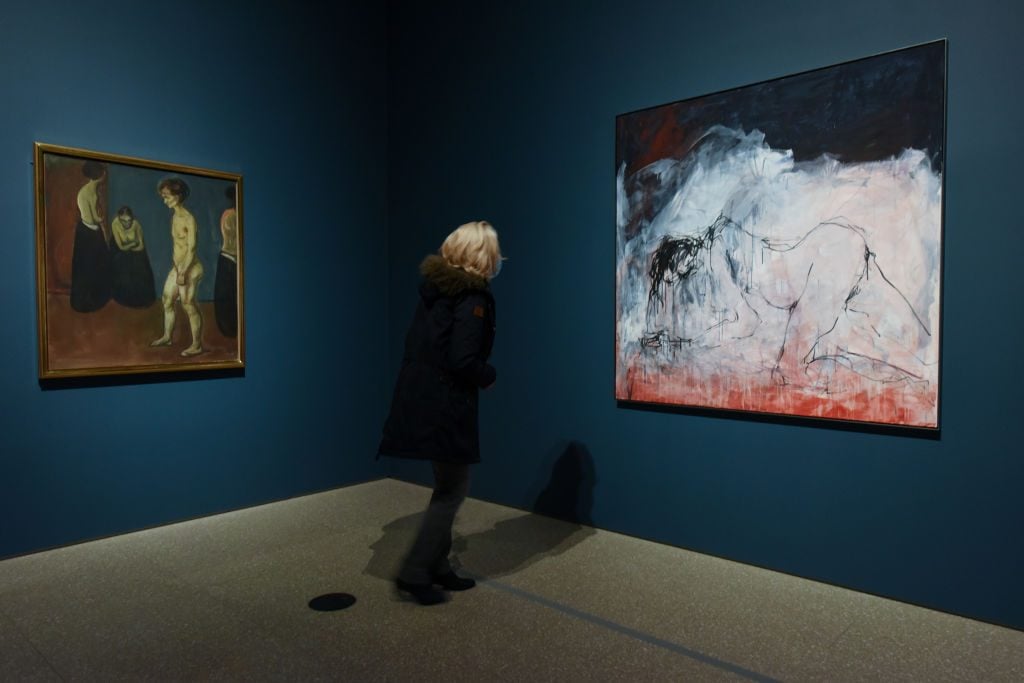
Women in Hospital (1897) by Edvard Munch and Title TBC (2019) by Tracey Emin during the “Tracey Emin/Edvard Munch: The Loneliness of the Soul” preview at Royal Academy of Arts, 2020 in London. Photo by Nicky J Sims/Getty Images.
She puts out her dark, sometimes bloody swatches of acrylic and scrawled poetry over whitewashed canvases in frenetic bursts.
Over the past year, she has been drawing a lot of self-portraits, and recently she has returned to the subject of her bed. “It is really silly because I’d never do bed paintings, it’s too cliché, it’s too much of a pastiche,” she said. “But actually it’s about return isn’t it? About going full circle. I made My Bed 23 years ago. I can return back to that subject if I like.”
Summoning the energy has been hard, not just because of her physical limitations, but a departure from old crutches like alcohol, which she hasn’t touched for more than a year. “I have to stoke up that fire all on my own now, so that’s kind of hard,” she said.
The experience of the past year has left her clearer-headed in other ways, too. “It’s up to me to show who I am, what I am and what I can do. I’m not relying upon other people or institutions or anything,” she said. “I love it. And it really empowers me. This is where I should be showing. This is my exhibition, this is my swan song … I’m doing the right thing. And if you know in your life that lots of times you were doing the wrong thing, and how uncomfortable it made you feel, and then suddenly you’re doing the right thing, it makes you feel so fucking good.”